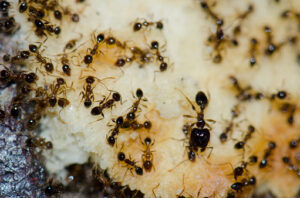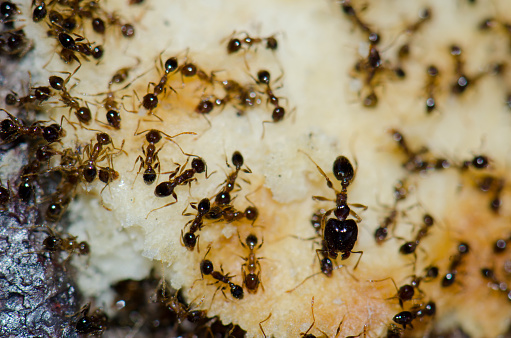Dreaded ants in and around your property can be aggravating; however, Argentine ants can be even more problematic as they are capable of producing huge colonies, which also includes sub-colonies, of over 1 million ants, which is more than enough ants to populate a full neighborhood block.
These native southern Brazil, Argentina, Uraguay, Bolivia, Paraguay ants who are believed to have made their way to the U.S. via coffee ships from Brazil sometime during the 1800s, typically thrive outdoors; however, they can make their way inside in large numbers, provided the conditions are right, which can lead to an infestation if they are not properly treated.
argentine ants
What are Argentine Ants?

Argentine ants are shiny dark brown ants, some are light brown, that generally range between 1/16 to 1/4 of an inch in length. However, the queens are a bit larger. They also have egg-shaped segmented bodies with antennae and six legs, similar to all ants, and they are wingless except when they are in the reproductive stage.
This species of ants are known to construct shallow nests in moist environments, such as under pathways, along sidewalks, beneath rocks and wood planks, and under plants, in close proximity to food sources, which is mainly sucrose based materials; however, during spring and summer, which is when they reach peak reproduction, their diet will change to mostly protein-rich foods.
As soon as the weather becomes too dry or too cold, large gatherings of Argentine ants are known to enter buildings to escape the temperature where they can be difficult to eliminate. Indoors, they are often found in high moisture areas, such as near potted plants, sinks, and water pipes.
Each Argentine ant colony can contain over 10 queens, who are also the only females in the colony who are capable of reproducing. In fact, the winged queens can also be spotted sometimes crawling behind the workers as they forage for food.
Do Argentine Ants Pose Any Risks?
Argentine ants do bite; however, they have only been shown to bite when they are provoked, but they do not have stingers.
Also, because they crawl over sewage, trash, and animal carcasses to reach their food; Argentine ants pose the same risk of spreading bacteria, via their legs, to food and other surfaces.
Argentine ants have also been shown to attack beehives, and even some domestic fowl, when they are in large numbers.
Treating Argentine Ants
One way Argentine ants make their way indoors is by utilizing utility wires or tree branches that connect to the building. Therefore, it is important to keep tree branches and other plants trimmed back to prevent ants from coming in.
Argentine ants also like moist areas, so be sure to remove any pools of water, such as portable pools, birdbaths, and outdoor equipment covers, to keep the ants at bay. Firewood, materials used for construction, and yard waste also attract Argentine ants, so be sure to store these materials as far away from the property as possible to prevent ants. Small gaps, cracks, and other openings should also be repaired as they can also allow Argentine ants indoors.
Inside, food should be stored in airtight containers, and any spills should be cleaned up right away to deter ants in search of sugary or high-protein foods. Likewise, any trash should also be removed regularly to discourage ants.
Meanwhile, at the first sighting of Argentine ants, a professional pest control technician can come to your property and inspect it for the best course or courses of action to eliminate your ant problem. Because Argentine ants are able to quickly reproduce after being eliminated, they can re-establish their colonies in no time, which makes them difficult to treat. This is why it is important to contact a professional technician who understands this and can develop the right plan, which may even include multiple treatments to address your specific issue and protect your property against future attacks.

